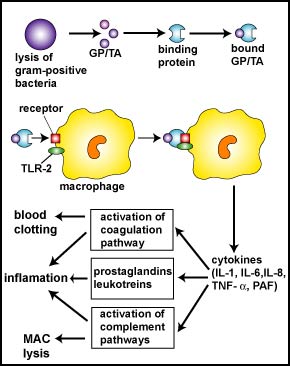
The lysis of gram-positive bacteria causes them to release glycopeptides (NAG-NAM-peptide monomers) and teichoic acids from their cell wall. These cell wall components most likely attach to binding protein circulating in the blood and this complex, in turn, binds to a receptor molecule found on the surface of body defense cells called macrophages. This triggers the macrophages to release various defense regulatory chemicals called cytokines, including IL-1, IL-6, IL-8, TNF-alpha, and PAF. The cytokines then bind to cytokine receptors on target cells and initiate inflammation and activate both the complement pathways and the coagulation pathway. (GP/TA, glydopeptides or teichoic acids; IL-1, interleukin-1; IL-6, interleukin-6; IL-8, interleukin-8, TNF-alpha, tumor necrosis factor-alpha; PAF, platelet-activating factor; MAC, membrane attack complex.)